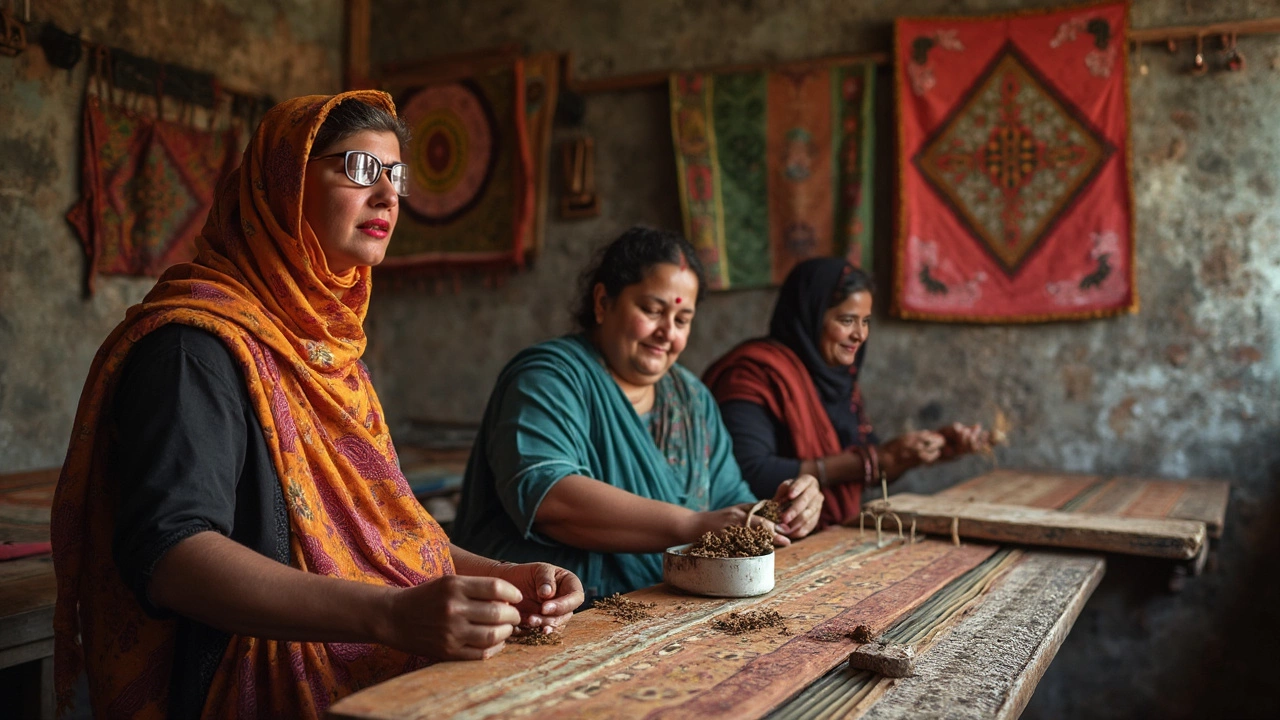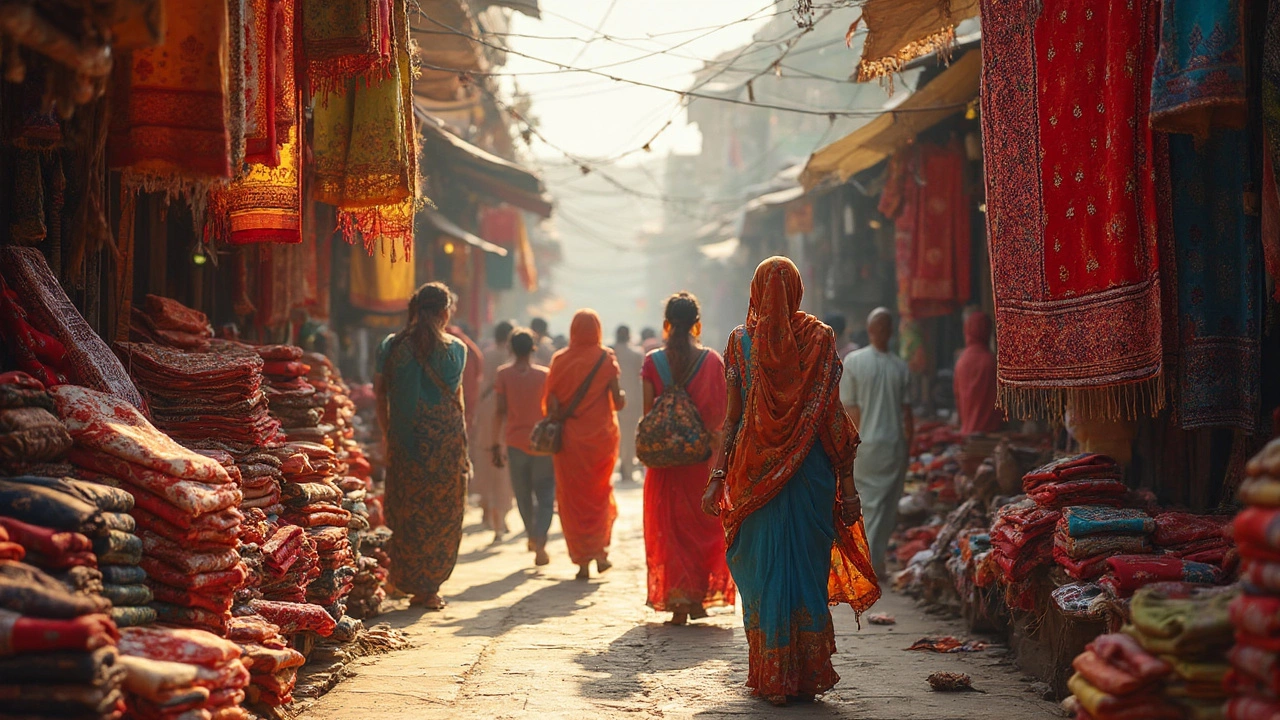If you’ve picked up a shirt or a scarf bursting with color and wild patterns at an Indian bazaar, odds are good it came from Gujarat. This state's textiles are a big deal—not just for India, but for fashion lovers everywhere. Gujarat’s cloth isn’t famous by accident. There’s serious history and skill woven into every meter.
The buzz mostly comes from Gujarat’s two big stars: bandhani and Patola. Bandhani is the OG tie-dye—tiny knots, crazy colors, and no two pieces are the same. Patola, on the other hand, is like wearable art—super detailed, handwoven, and it takes months to finish just one sari. These aren’t just pretty fabrics; they’re proof of how much energy and know-how the state puts into its cloth.
Beyond tradition, Gujarat’s factories are some of the most advanced in India. The state pumps out cotton, denim, and synthetic fabrics for countless brands. This combo of old-school and high-tech has made Gujarat the go-to zone for anyone serious about textiles. Thinking about visiting or buying? Stick around—there are tips and facts coming up that’ll help you spot top-quality Gujarat fabric without getting lost in the market chaos.
- What Makes Gujarat’s Cloth Stand Out
- Signature Fabrics You Can’t Miss
- A Sneak Peek Into the Manufacturing Process
- Tips for Buyers and Textile Lovers
What Makes Gujarat’s Cloth Stand Out
When it comes to Indian textiles, Gujarat is a heavyweight. It’s not just about volume; it’s about what sets the cloth apart from the rest. The state has cracked a rare mix of tradition, skill, and modern hustle. Let’s break down why everyone from big brands to street sellers chase Gujarat’s fabric.
First up, Gujarat has been known as India’s textile center for ages. There’s a textbook example sitting along the Sabarmati River—Ahmedabad used to be called the “Manchester of India” for its dense cluster of cotton mills. Even today, nearly 35% of India’s textile mills run out of Gujarat.
But cotton isn’t the only thing happening here. The Gujarat cloth scene includes silk, denim, and those famous hand-dyed wonders. Bandhani (tie-and-dye) and Patola (double ikat weaving) are legendary. These styles aren’t just pretty—they’re tough to make, and it shows in the detail and bold, lasting color. Patola saris, for example, can take up to six months to weave by hand, making them real collector’s items.
If you like facts and numbers, check out how Gujarat stacks up:
| Category | Gujarat’s Share in India |
|---|---|
| Cotton production | About 33% |
| Denim production | Over 65% |
| Textile mills | Nearly 35% |
| Textile exports | Over 20% |
Another thing that makes these fabrics stand out is the fusion of old-school techniques with huge, modern factories. While highways are lined with handloom workshops, you’ll also see giant plants churning out denim for international brands. Some of India’s best-known denim comes straight from Surat and Ahmedabad.
What’s the takeaway? Gujarat’s textile power isn’t just from old traditions. It’s the mashup of skilled artisans, smart manufacturers, and access to raw material. If you want something unique or want to buy big, Gujarat is where you start your search.
Signature Fabrics You Can’t Miss
When someone talks about Gujarat’s textiles, the first thing that pops up isn’t just one fabric. This state knows how to keep things fresh, so you’ll find a crazy variety—each with its own backstory. Let’s break down the stuff you’ve got to check out if you’re hunting for something classic or just want a slice of local culture.
- Bandhani: Picture a cloth with tiny dots, squiggles, or even elephant shapes, all in wild colors. That’s bandhani. It’s made by tying bits of fabric into knots—sometimes by entire families—then dunking it in dye. You don’t really see the full pattern until the knots come out. Bandhani shows up in dupattas (long scarves), turbans, and kurtas, especially during festivals or big weddings. Even high-end designers have started mixing bandhani with modern styles.
- Patola: If you’ve never seen a double ikat sari from Patan (small town, big reputation), you’re missing out. Every inch is handwoven with colored threads, both warp and weft. No prints, no shortcuts. One genuine Patola sari can take 6 months to a year to finish—and that means they’re pricey. What makes them stand out? You get crisp geometric, animal, or floral designs, and the colors don’t fade, no matter how old it gets.
- Ajrakh: This is the other rock star from Kutch. Ajrakh uses block printing, mostly natural dyes, and gets its classic indigo-and-red look after several wash and print cycles. If you’re into eco-friendly or “slow fashion,” Ajrakh ticks all the boxes.
- Mashru: Ever wondered how to get the shine of silk without the drama? Mashru does this blending silk and cotton in the same weave. It feels cool, works for Gujarat’s hot weather, and pops up a lot in men’s jackets and women’s blouses.
Gujarat also produces a ton of cotton, denim, and synthetics in mega mills. These jobs make the state the top textile hub, not just for fancy stuff, but for the everyday clothes you actually wear.
| Fabric | Main Origin City | Speciality | Average Price (INR) |
|---|---|---|---|
| Bandhani | Jamnagar, Bhuj | Tie-dye, vibrant | 300–5,000 |
| Patola | Patan | Double ikat, handmade | 80,000–5,00,000 |
| Ajrakh | Dhamadka, Ajrakhpur | Block printed, natural dyes | 1,000–12,000 |
| Mashru | Surendranagar | Silk-cotton blend | 800–4,000 |
People get drawn in by the colors and designs, but if you look closer, you’ll see why Gujarat is called India’s Gujarat cloth capital. Whether shopping in a market or picking out fabric for a new outfit, these are the must-knows to find the real deal.

A Sneak Peek Into the Manufacturing Process
Ever wonder what actually goes down in a Gujarat textile workshop? It’s not just rows of machines. There’s a mix of tradition and top-level technology, depending on what type of cloth you’re after—including the hugely popular Gujarat cloth like bandhani and Patola.
Let’s talk about bandhani first. This process is hands-on: workers pinch tiny sections of fabric and tie them with thread, creating hundreds or even thousands of knots. The fabric gets dunked in dye, and those knots turn into eye-popping patterns once untied. Families in Kutch, Jamnagar, and Bhuj have been doing this for generations, passing down techniques and even secret color formulas.
Patola is next-level. Here’s the wild part: the yarn itself is dyed before it’s even woven. Weavers line up every color so the pattern appears when the threads finally meet on the loom. Each Patola sari can take six months or more—no shortcuts. Only a handful of families in Patan are experts at this method, which is why genuine Patola cloth is pricey and rare.
On the industrial side, Gujarat’s textile factories are powerhouses. The process usually goes:
- Raw cotton arrives, gets cleaned and spun into yarn.
- The yarn is dyed—sometimes using huge vats, sometimes with more precise, eco-friendly methods.
- Machines weave the yarn into different fabrics like denim, poplin, or synthetic blends.
- Next, the cloth is finished—washed, stretched, maybe even printed with designs.
Tips if you’re scouting for fabric in Gujarat: Look for tight weaves in bandhani (fewer knots means weaker fabric), check edges for neatness in Patola, and always ask if the process is hand-done or machine-made. Quality really varies, and the details matter, especially if you want something that lasts.
Tips for Buyers and Textile Lovers
Shopping for Gujarat’s cloth is a thrill—so much color, detail, and variety. But it can get confusing fast. Here’s how to make sure you’re snagging the real stuff and not some average knockoff.
- Gujarat cloth usually shines in markets like Ahmedabad’s Law Garden or Rajkot’s Bangdi Bazaar. Want authentic? These spots rarely disappoint, and local vendors know their stuff.
- Check the yarn. Real bandhani uses fine cotton or silk that feels soft but not flimsy, with tight, tiny dots where the fabric was knotted. If the color bleeds or the dots look smudged, move on.
- With Patola, the price is a dead giveaway. Genuine double ikat Patola saris can run over ₹1 lakh (about $1,200). If someone’s hawking it for a tenth of that, you’re looking at a replica, probably made with a power loom.
- Always ask if the fabric is handloom or powerloom. Handloom pieces are pricier, sure, but the story, the look, and the quality are on another level.
Thinking about buying in bulk or for a boutique? Gujarat’s textile factories also lead the country in export volume. Take Surat—known as the 'Silk City'—it pushes out over 20 million meters of fabric daily. If you’re serious, talk directly to manufacturers to cut costs and get customization.
| Type | What to Look For | Typical Price Range |
|---|---|---|
| Bandhani | Tight, neat knots; vibrant colors | ₹300 - ₹8,000 |
| Patola (Handwoven) | Sharp patterns, same look on both sides | ₹20,000 - ₹1,50,000 |
| Khadi | Rougher texture, earthy colors | ₹250 - ₹2,500 |
| Surat Silk | Glossy, light feel, even weave | ₹50 - ₹5,000 |
One last tip—don’t skip the care instructions. Most Gujarat fabrics, especially natural dyes, need gentle washing. Skip the harsh detergents and sunlight if you want those colors to pop for years.
